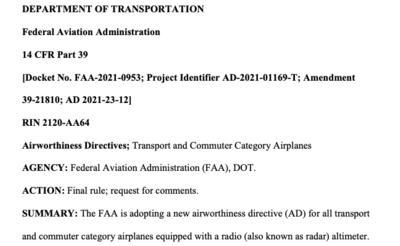Wed, Dec 08, 2021
AFMs to Prohibit Radio Altimeter Use by NOTAMS At Appropriate Airports
The FAA has issued 2 new airworthiness directives regarding the impending (and temporarily postponed) rollout of 5G networks.

An addition to the approved AFMs for transport and commuter category aircraft will be amended with updated radio altimeter flight restrictions, for select locations to be named by NOTAMs for the area. The agency also invites aeronautical, avionics, and telecommunications companies to help identify exactly which areas are most likely to develop signal interference or altimeter errors. The agency is on a shorter timeline than usual, noting that a number of 5G network providers are due to begin service in January 2022. The public has 45 days to review and comment on the changes, with the amendments effective once published to the federal register.
The FAA plans to use the data provided by telecomms providers to determine exactly which C-Band base stations or similar technology that would impact altimeter operation at the appropriate airports. Of course, the change in usable instrumentation could significantly alter approach procedures, noting "these limitations could prevent dispatch of flights to certain locations with low visibility, and could also result in flight diversions."

Directive 01169-T specifically notes that although the normal, lengthy issuance process has been omitted, "the FAA has found that the risk to the flying public justifies forgoing notice and comment prior to adoption of this rule because radio altimeter anomalies that are undetected by the aircraft automation or pilot, particularly close to the ground (e.g. landing flare), could lead to loss of continued safe flight and landing. The urgency is based on C-Band wireless broadband deployment, which is expected to occur in phases with operations beginning as soon as January 5, 2022. Accordingly, notice and opportunity for prior public comment are impracticable and contrary to the public interest."
More News
Aero Linx: JAARS Nearly 1.5 billion people, using more than 5,500 languages, do not have a full Bible in their first language. Many of these people live in the most remote parts of>[...]
'Airplane Bounced Twice On The Grass Runway, Resulting In The Nose Wheel Separating From The Airplane...' Analysis: The pilot reported, “upon touchdown, the plane jumped back>[...]
"Burt is best known to the public for his historic designs of SpaceShipOne, Voyager, and GlobalFlyer, but for EAA members and aviation aficionados, his unique concepts began more t>[...]
"Polaris Dawn, the first of the program’s three human spaceflight missions, is targeted to launch to orbit no earlier than summer 2024. During the five-day mission, the crew >[...]
There Are SO Many Ways To Get YOUR Aero-News! It’s been a while since we have reminded everyone about all the ways we offer your daily dose of aviation news on-the-go...so he>[...]
 ANN's Daily Aero-Linx (05.04.24)
ANN's Daily Aero-Linx (05.04.24) NTSB Final Report: Quest Aircraft Co Inc Kodiak 100
NTSB Final Report: Quest Aircraft Co Inc Kodiak 100 Aero-News: Quote of the Day (05.04.24)
Aero-News: Quote of the Day (05.04.24) Aero-News: Quote of the Day (05.05.24)
Aero-News: Quote of the Day (05.05.24) Read/Watch/Listen... ANN Does It All
Read/Watch/Listen... ANN Does It All




